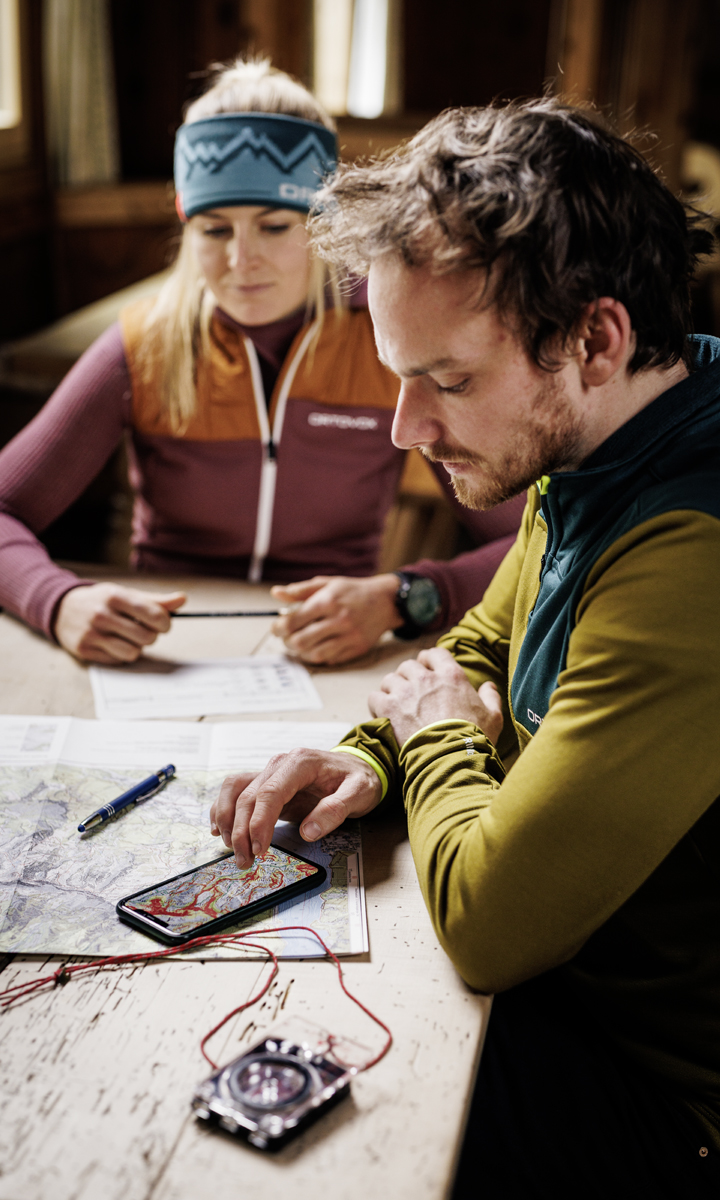VIDEO
Trailer: SAFETY ACADEMY LAB SNOW
About the lab
SAFETY ACADEMY LAB SNOW
PIONEERS IN SAFETY
As a leading provider of mountain sports equipment, ORTOVOX has seen it as its duty to prepare mountaineers for alpine challenges as best it can – and not only by developing groundbreaking products. Sharing alpine knowledge based on the latest research is one of ORTOVOX’s core concerns.
That’s why a new edition of SAFETY ACADEMY LAB SNOW is now being launched. The completely reworked multimedia e-learning platform for freeriders and ski tourers provides essential avalanche basics – now with three times as much state-of-the-art content. The new LAB SNOW is also even more emotional and more focused: clearer, with attractive animations and illustrations, and easier to navigate – even on a smartphone.
In close cooperation with the Verband deutscher Berg- und Skiführer (VDBS – German Mountain and Ski Guide Association), numerous professional mountain guides, and safety and first aid experts, ORTOVOX has completely reworked its SAFETY ACADEMY LAB SNOW, which has received widespread attention. The new interactive, multimedia training platform clearly and comprehensibly sets out all the important safety aspects of ski touring and freeriding across four chapters with 16 video tutorials, comprehensive educational modules and numerous quizzes. All of the content is aimed at beginners and advanced freeriders and ski tourers.
SAFETY ACADEMY - BACKGROUND
Since the company was founded in 1980, ORTOVOX has dedicated itself to protection. Here, protection not only refers to innovative emergency products, but also to in-depth knowledge that provides protection on the mountains.
ORTOVOX provides this information together with professional mountain guides and experts via the SAFETY ACADEMY: What first began as an initiative purely for avalanche courses is now targeted towards complete alpine safety training – in both summer and winter, digitally and on paper.
SHORT SUMMARY OF THE CHAPTERS
RESCUING A COMPANION, FIRST AID & PROFESSIONAL RESCUE
In an ideal situation, you would identify and avoid terrain at risk of an avalanche from the start. If an avalanche nevertheless occurs, all participants must know exactly what to do and act quickly. Chapter four takes a detailed look at all the aspects of avalanche rescue – from companion rescue including an emergency call, avalanche transceiver search, probing and shoveling, through to first aid and professional rescue services.
RISK MANAGEMENT IN THE MOUNTAINS & SNOW PROFILES
Chapter three is all about responsible risk management in the mountains. It clarifies the following questions: How is an avalanche transceiver check done? What kind of warning signs are there? How should avalanche problems be assessed when in the mountains? And how should the DCMR method be used on a tour? This chapter also deals comprehensively with snow profiles and provides information about what taking a look at the snowpack can reveal.
THE BASICS OF TOUR PLANNING & SKI TOURING EQUIPMENT
The second part of the LAB SNOW deals with tour planning – the cornerstone of a safe tour. It clarifies the meaning of the avalanche bulletin in detail, how to rank the five danger levels and the avalanche problems that exist. It also introduces the DCMR method developed by the VDBS for assessing avalanches. This chapter also provides a compact overview of the equipment needed for a ski tour
AVALANCHE BASICS & AVALANCHE FACTORS
Avalanche danger is one of the most complex topics in mountain sports, and is often difficult to grasp. The first LAB SNOW chapter provides an overview of avalanche basics. It explains what types of avalanche there are, what you need to know about snow slabs in particular, how the factors that contribute to the formation of avalanches interact and what the 3x3 filter method is all about.
The people
The names behind the SAFETY ACADEMY LAB ROCK are safety experts Chris Semmel and Walter Würtl, avalanche researcher Ben Reuter and first-aid expert Dani Hornsteiner:


Chris Semmel is a state-certified mountain and ski guide as well as an expert on mountain, climbing and avalanche accidents. He was a VDBS trainer for many years, led the DAV (German Alpine Club) safety research team for ten years, and is a member of the DAV mountaineering and sport climbing training team.
Walter Würtl is also a state-certified mountain and ski guide as well as an expert on alpine and avalanche accidents. As an alpine scientist, he is also the editor of bergundsteigen magazine.
Ben Reuter is a state-certified mountain and ski guide. As an avalanche scientist, he also works for the Swiss Institute for Snow and Avalanche Research (SLF) and the French avalanche warning services.
Dani Hornsteiner is a paramedic as well as a trainer and head of operations at Bergwacht Bayern (Bavarian Mountain Rescue). She has run alpine first aid courses for many years, now as part of her own company. As an active mountaineer and DAV guide for high alpine and ski tours, she has a wealth of alpine knowledge to call on.




